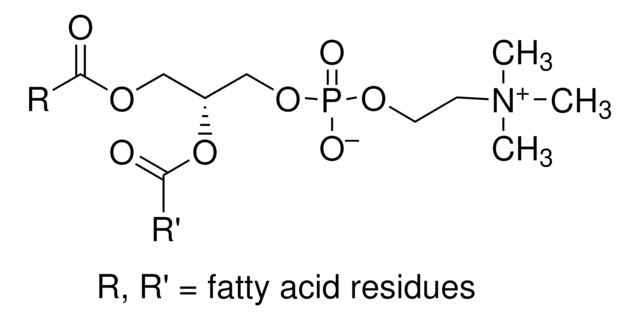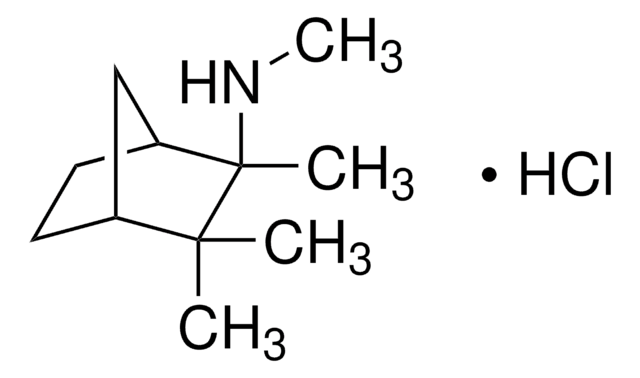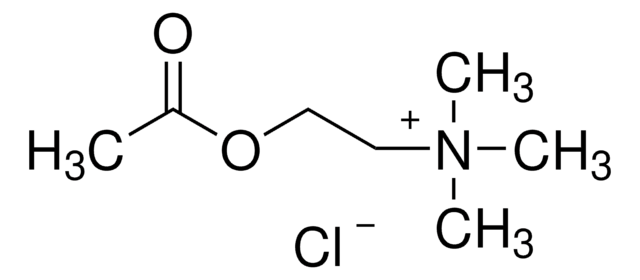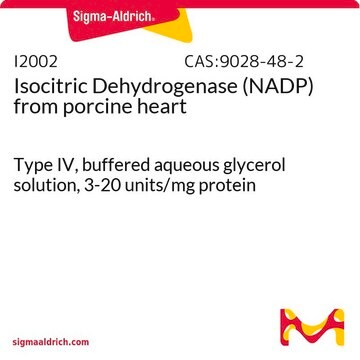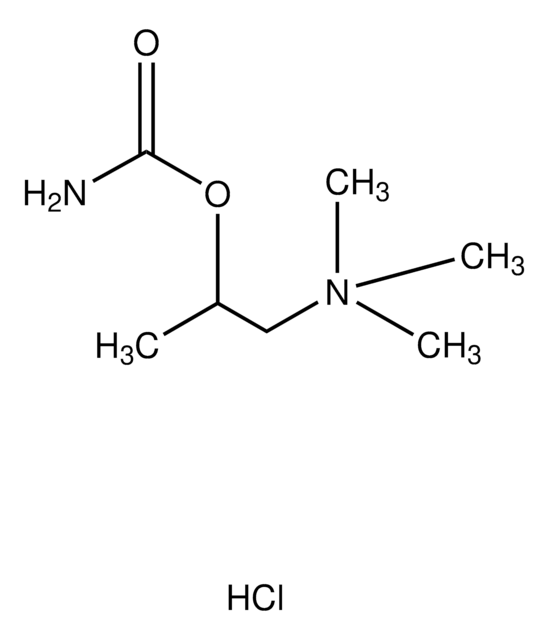C5366
Chlorisondamine diiodide
≥98% (HPLC), white, solid
동의어(들):
4,5,6,7-Tetrachloro-2,3-dihydro-2-methyl-2-[2-(trimethylammonio)ethyl]-2H-isoindolium diiodide
로그인조직 및 계약 가격 보기
모든 사진(1)
About This Item
실험식(Hill 표기법):
C14H20Cl4I2N2
CAS Number:
Molecular Weight:
611.94
MDL number:
UNSPSC 코드:
12352116
PubChem Substance ID:
NACRES:
NA.77
추천 제품
분석
≥98% (HPLC)
양식
solid
저장 조건
protect from light
색상
white
solubility
H2O: ≥2 mg/mL
DMSO: >20 mg/mL
저장 온도
2-8°C
SMILES string
[I-].[I-].C[N+](C)(C)CC[N+]1(C)Cc2c(Cl)c(Cl)c(Cl)c(Cl)c2C1
InChI
1S/C14H20Cl4N2.2HI/c1-19(2,3)5-6-20(4)7-9-10(8-20)12(16)14(18)13(17)11(9)15;;/h5-8H2,1-4H3;2*1H/q+2;;/p-2
InChI key
FPNVAOZHQUJJJQ-UHFFFAOYSA-L
애플리케이션
Chlorisondamine diiodide has been used:
- as a nicotinic receptor antagonist to test its effect on trinitrobenzene sulfonic acid (TNBS)-induced colitis
- as an irreversible nicotinic acetylcholine(nAChR) blocker to pre-treat brain samples to test its effect on cytochrome P450 2B (CYP2B) induction
- as a ganglionic blocker to test its effect on regulating corticosterone levels in rat with chronic stress
생화학적/생리학적 작용
Chlorisondamine diiodide mediates ganglionic and central blockade.
Irreversible, long-lasting nicotinic acetylcholine receptor antagonist.
특징 및 장점
This compound is a featured product for Neuroscience research. Click here to discover more featured Neuroscience products. Learn more about bioactive small molecules for other areas of research at sigma.com/discover-bsm.
This compound is featured on the Acetylcholine Receptors (Nicotinic) page of the Handbook of Receptor Classification and Signal Transduction. To browse other handbook pages, click here.
신호어
Warning
유해 및 위험 성명서
예방조치 성명서
Hazard Classifications
Acute Tox. 4 Oral - Aquatic Acute 1
Storage Class Code
11 - Combustible Solids
WGK
WGK 2
Flash Point (°F)
Not applicable
Flash Point (°C)
Not applicable
개인 보호 장비
dust mask type N95 (US), Eyeshields, Gloves
G Costa et al.
Brain research, 888(2), 336-342 (2001-01-11)
While the work of several groups has shown the neuroprotective effects of nicotine in vitro, evidences for the same effects in vivo are controversial, mainly regarding neuroprotection in experimental models of Parkinson's disease. In this context, we investigated the capability
T Marenco et al.
British journal of pharmacology, 129(1), 147-155 (2000-02-29)
Chlorisondamine blocks central nicotinic receptors for many weeks via an unknown mechanism. Intracerebroventricular administration of [(3)H]-chlorisondamine in rats results in an anatomically restricted and persistent intracellular accumulation of radioactivity. The initial aim of the present study was to test whether
T Mori et al.
Molecular pharmacology, 59(4), 732-743 (2001-03-22)
Inhalational general anesthetics have recently been shown to inhibit neuronal nicotinic acetylcholine (ACh) receptors (nnAChRs) expressed in Xenopus laevis oocytes and in molluscan neurons. However, drug actions on these systems are not necessarily the same as those seen on native
A Bai et al.
Scandinavian journal of immunology, 66(5), 538-545 (2007-10-24)
Inflammatory bowel diseases (IBD) are characterized by proinflammatory cytokines, tissue damage and loss of neuron in inflamed mucosa, which implies the cholinergic anti-inflammatory pathway may be destroyed during the process of inflammatory response. In the study, we identified the effect
Colin S Cunningham et al.
Pharmacology, biochemistry, and behavior, 179, 27-33 (2019-02-10)
Mecamylamine is a non-competitive nicotinic acetylcholine receptor (nAChR) antagonist that has been prescribed for hypertension and as an off-label smoking cessation aid. Here, we examined pharmacological mechanisms underlying the interoceptive effects (i.e., discriminative stimulus effects) of mecamylamine (5.6 mg/kg s.c.)
관련 콘텐츠
DISCOVER Bioactive Small Molecules for Neuroscience
자사의 과학자팀은 생명 과학, 재료 과학, 화학 합성, 크로마토그래피, 분석 및 기타 많은 영역을 포함한 모든 과학 분야에 경험이 있습니다..
고객지원팀으로 연락바랍니다.
